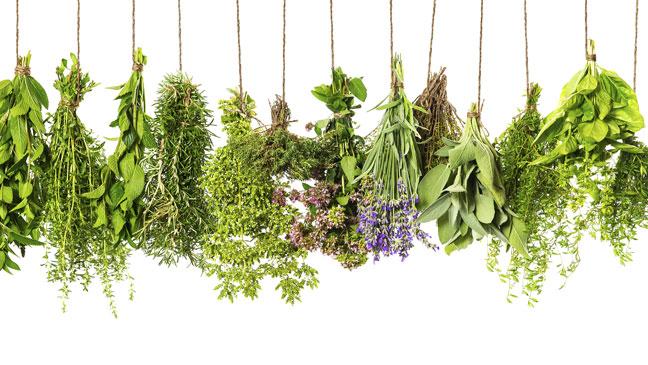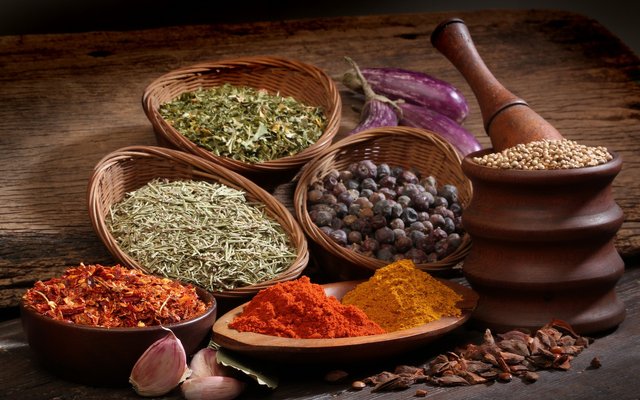An Herb For Every Ailment
Hello Steemers: I'm Back with a brief history lesson about the amazing treasures lurking in your kitchen cabinets right now that you might or might not use that often but should use to make your overall life better and shift from depending on pharmaceuticals drugs and remedies that aren't natural and only mask symptoms instead of solving the problem and go toward a more healthy lifestyle and eat your way to good health, and flavor. Not Fat, Salt or Chemicals to mask poor quality or increase shelf life.

It's a Lifestyle Choice
I for one have tried to incorporate and shift my lifestyle toward a healthier one with a watchful eye on what i can learn to make it better each day, knowledge is the answer to it all and it begins with a credible source, history is history i can doll it up with flashy words and pictures but it wont change the one important thing. The Facts. I give them to you here.
And The list goes on and on
Seasoning, Teas, Tinctures, Essential Oils, And blends of certain Dried flowers and herbs can Do Wonders for your body and you can eat, drink, rub them on your skin, inhale the vapors, or even smoke them. There are millions of cures and remedies lurking just behind the cabinet door in your garden and at your grocery store. It's free info and it's all there plain to see. Why not look at it. This is just the beginning I read many books and articles and talk to professionals daily to find out what more I can do, to make my life better so should you. I seek to educate people the power that they already have is not being used.. it's in our blood.

A Brief History of Herbalism
Source: The University Of Virginia
The use of plants for medicinal purposes
The ancient Chinese, Indians, Egyptians, Babylonians, and Native Americans were all herbalists. The oldest known list of medicinal herbs is Shen Nung’s Pen Ts’ao or Shennong Ben Cao Jing (c. 3000 B.C.), a Chinese herbal that is probably a compilation of an even older oral tradition.
The ancient Greeks and Romans were also renowned herbalists. Surgeons traveling with the Roman army spread their herbal expertise throughout the Roman empire, in Spain, Germany, France, and England. Dioscorides (c. 40-c. 90) and Galen (131-200 A.D.), both Greek surgeons in the Roman army, compiled herbals that remained the definitive materia medica texts for 1500 years.
Through the Middle Ages, herbalism was preserved in the monasteries of Britain and mainland Europe. Before the establishment of universities in the eleventh and twelfth centuries, monasteries served as medical schools. Monks copied and translated many of the works of Hippocrates, Dioscorides, and Galen. Their “physick” gardens, well-stocked with the most common and useful medicinal herbs, served as basic training grounds for the next generation of physicians–monks and laymen alike.
Meanwhile, as a result of the Islamic conquest of North Africa in the seventh and eighth centuries, Arabic scholars acquired many Greek and Roman medical texts. Iranian physician Ibn Sina, also known as Avicenna (980-1037 A.D.), combined the herbal traditions of Dioscorides and Galen with the ancient practices of his own people in The Canon of Medicine (al-Qanun fi at-tibb). One of the most influential medical texts ever written, Avicenna’s Canon spread through Europe during the eleventh and twelfth centuries.
With the invention of the printing press in the mid-fifteenth century, the herbals of Dioscorides, Galen, and Avicenna were mass-produced and made accessible to people outside the palace, the monastery, and the university. Use of the herbals required no specialized skills: readers simply gathered the herbs and applied them in the prescribed manner and dosage.
Parcelsus

Each physician-gardener who compiled a new herbal sought to revolutionize, or at least standardize, the use of medicinal plants. One such writer was Theophrastus Bombastus von Hohenheim, better known as Paracelsus (1493-1541). He emphasized the importance of experience with patients and railed against blind faith in the ancient physicians.
Despite his announced distrust of traditional herbalism, Paracelsus revived the first-century “doctrine of signatures.” According to the doctrine of signatures, every herb has its own “sign.” The appearance of the plant, and its color, scent, or living environment indicated its medicinal use. Herbs used to cure jaundice, for instance, included marigold and dandelion and other plants with yellow flowers, while pansies, with their heart-shaped petals, were used for heart troubles.
Twelve signs of the Zodiac

A century later, Englishman Nicholas Culpeper (1616-1654) revitalized another ancient facet of herbalism: astrology. Astrological herbalists connected herbs to different signs of the zodiac. They treated specific ailments by determining what sign and planet ruled over the part of the body that needed care and then prescribing an herb of the same astrological sign. According to Culpeper, “he that would know the reason of the operation of the Herbs, must look up as high as the stars.”
William Harvey

While Paracelsus and Culpeper promoted the doctrine of signatures and astrological herbalism, medical practice was changing. Men like Francis Bacon (1561-1626) and William Harvey (1578-1657) were transforming science from a speculative to an experimental process. This new emphasis did not mix well with the revival of the doctrine of signatures and astrology: thus, biological and medical science began to separate from traditional herbalism. Herbalists who focused on classification and refused to acknowledge signatures and stars formed the science of botany. Physicians who found Harvey’s circulation of the blood more useful than Culpeper’s movements of the planets started what might be called scientific medicine.
The four herbals highlighted in this exhibit are milestones in the history of western herbal medicine, from its classical source to its drift from medical science.
This educational excerpt from their website describes that historically and globally that we are all made up of the same organic material and react similarly to certain natural attributes found existing in the everyday spices and seasonings used in cuisines around the world. In most cases the poverty stricken desolate parts of the world are just as if not healthier than the countries with access to pharmaceuticals and un natural symptom covering chemicals.
I have set out to educate everyone I can that they have a choice and the choice is pretty easy. It's a natural choice.
Have A Healthy Day And Don't forget to visit often to see what food for thought I'm serving up next.